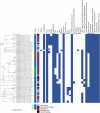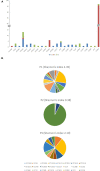Genetic Diversity of Listeria monocytogenes Isolated From Three Commercial Tree Fruit Packinghouses and Evidence of Persistent and Transient Contamination
- PMID: 35082763
- PMCID: PMC8784831
- DOI: 10.3389/fmicb.2021.756688
Genetic Diversity of Listeria monocytogenes Isolated From Three Commercial Tree Fruit Packinghouses and Evidence of Persistent and Transient Contamination
Abstract
Whole genome analysis was performed on 501 isolates obtained from a previous survey which recovered 139 positive environmental sponge samples (i.e., up to 4 isolates per sample) from a total of 719 samples collected at 40 standardized sites in 3 commercial apple packinghouse facilities (i.e., P1, P2, and P3) over 3 successive seasons in a single production year. After excluding duplicated isolates, the data from 156 isolates revealed the clonal diversity of L. monocytogenes and allowed the detection of transient contamination, persistent contamination, and cross-area transmission events. Facility P2 with the poorest sanitary conditions had the least diversity (Shannon's index of 0.38). P2 contained a Clonal Complex (CC) 554, serogroup IVb-v1 strain that persisted throughout the year and spread across the entire facility, a singleton Sequence Type (ST) 1003, lineage III strain that persisted through two seasons and spread across two areas of the facility, and 3 other clones from transient contaminations. P1 and P3, facilities with better sanitary conditions, had much higher diversity (i.e., 15 clones with a Shannon's index of 2.49 and 10 clones with a Shannon's index of 2.10, respectively) that were the result of transient contamination. Facilities P1 and P3 had the highest incidence (43.1%) of lineage III isolates, followed by lineage I (31.3%) and lineage II (25.5%) isolates. Only 1 isolate in the three facilities contained a premature stop codon in virulence gene inlA. Fourteen samples yielded 2-3 clones per sample, demonstrating the importance of choosing appropriate methodologies and selecting a sufficient number of isolates per sample for studying L. monocytogenes diversity. Only 1 isolate, belonging to CC5 and from facility P3, contained a known plasmid, and this was also the only isolate containing benzalkonium chloride tolerance genes. The persistent CC554 strain did not exhibit stronger sanitizer resistance than other isolates and did not contain any confirmed molecular determinants of L. monocytogenes stress resistance that were differentially present in other isolates, such as genes involved in sanitizer tolerance, heavy metal resistance, biofilm-forming, stress survival islet 1 (SSI-1), stress survival islet 2 (SSI-2) or Listeria genomic island (LGI2).
Keywords: Genomics; Listeria; apple; diversity; packinghouse.
Copyright © 2022 Chen, Simonetti, Peter, Jin, Brown, LaBorde and Macarisin.
Conflict of interest statement
The authors declare that the research was conducted in the absence of any commercial or financial relationships that could be construed as a potential conflict of interest.
Figures



References
-
- Angelo K. M., Conrad A. R., Saupe A., Dragoo H., West N., Sorenson A., et al. (2017). Multistate outbreak of Listeria monocytogenes infections linked to whole apples used in commercially produced, prepackaged caramel apples: United States, 2014–2015. Epidemiol. Infect. 145 848–856. 10.1017/S0950268816003083 - DOI - PMC - PubMed
-
- Centers for Disease Control and Prevention (2015). Wholesome Soy Products, Inc. Sprouts and Investigation of Human Listeriosis Cases (Final Update). Atlanta, GA: Centers for Disease Control and Prevention.
LinkOut - more resources
Full Text Sources

